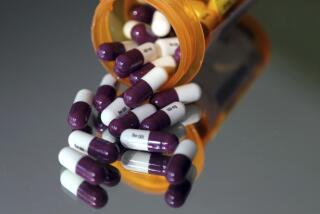FDA OKs First of New Batch of AIDS Drugs
- Share via
WASHINGTON — The Food and Drug Administration on Thursday formally approved the first of a new generation of powerful AIDS drugs, a family of compounds that appear at least 10 times more potent than the existing most widely prescribed antiviral therapies.
The agency’s approval of the first of those drugs, saquinavir, came in record time--only three months after the company applied for licensing and one month after an FDA advisory committee urged the agency to send it to the market.
Saquinavir is from a new group of antiviral AIDS drugs known as protease inhibitors. AIDS researchers have been excited about the potential offered by the drugs, particularly when they are used in combination with other AIDS drugs known as nucleoside analogs. The latter include the commonly used AZT, DDI, DDC, D4T, and the recently approved 3TC.
Saquinavir is made by Roche Laboratories of Nutley, N.J., and will be manufactured under the trade name Invirase.
The FDA emphasized the swiftness of its decision to OK the drug, with Commissioner David A. Kessler calling it “the fastest approval of any AIDS drug so far.” The action “demonstrates FDA’s flexibility in situations when saving time can mean saving lives,” he said.
The agency has been under attack from conservative groups and members of Congress for failing to deliver promising lifesaving therapies to the public as quickly as its foreign counterparts.
In the case of AIDS drugs, however, the United States has acted far more rapidly than European nations. Three of the six major AIDS drugs on the market here are not yet available in Europe.
The FDA approved the use of the drug in conjunction with the nucleoside analogs AZT and DDC. This approach reflects the recent thinking among most AIDS researchers and physicians that the most effective way to prolong life after infection with HIV is to hit the virus with a multiple punch.
Protease inhibitors and nucleoside analogs both address the underlying viral condition. Each attacks the virus at a different point in its reproductive cycle.
To survive, the virus must make copies of itself in the body. To do so, it integrates itself into CD4 immune system cells and, in effect, turns the cells into little virus factories. The process kills CD4 cells, thus decimating the immune system and making the body vulnerable to a range of life-threatening infections.
Nucleoside analogs attack the virus early in its replication cycle, while protease inhibitors act during the later stages. Protease inhibitors block the virus from using a critical enzyme known as proteinase to complete replication. A new virus is produced, but it is harmless. The hope is that this will prevent destruction of the immune system.
The strategy of a many-pronged attack is to dismantle the virus and to reduce the possibility that the virus will develop resistance, as almost invariably happens to all AIDS antiviral drugs.
Resistance occurs when the virus mutates in a way that thwarts the effects of the drug. Researchers believe that the problem could be reduced when drugs are used in combination, speculating that mutants developed in response to one drug will be killed by another.
Roche officials said that the drug would be on pharmacy shelves within 48 hours. The company said that the wholesale price of a daily dose will be $15.89.
Saquinavir is one of six protease inhibitors under study.
More to Read
Sign up for Essential California
The most important California stories and recommendations in your inbox every morning.
You may occasionally receive promotional content from the Los Angeles Times.













